If you manage a factory or buy from one and aren't familiar with process control plans, it's important for you to understand their function and how to use them.
Successfully filling out a process control plan to raise product quality consists of creating a document detailing every production step, its controls, and established standards. This blueprint streamlines operations, ensuring consistent product quality.
What is a Process Control Plan?
A process control plan is a document that sets out the quality system components necessary to deliver high-quality products. It is one of the 'core tools' mentioned in the TS 16949 standard.
Having a good quality management system is crucial to maintaining consistent product quality, and the control plan outlines the details and steps involved in achieving that quality standard.
A process control plan looks like this:

It lists all production processes (if possible, it will include those of the sub-suppliers too). If you are an importer and you can't spend much time working with your suppliers, the minimum you need is a quality control plan for defining expectations for the finished product.
Why is a Process Control Plan Important?
A process control plan can help enhance operational efficiency, minimize risk, and most importantly, ensure consistent product quality. This strategic plan acts as a blueprint for quality management, laying down the processes that need to be controlled, monitoring mechanisms, and responses when deviations occur. It is crucial because it creates a structured approach to managing variability in manufacturing processes, which can directly impact a business's bottom line.
Understanding the importance of a process control plan brings us to its key benefits:
- Clarity and Consistency: It ensures each process area knows what they need to do to maintain quality, and they understand how their work is evaluated. This leads to consistency in production, reduced error rates, and increased efficiency.
- System Evaluation and Improvement: The plan allows for the evaluation of the existing quality system and the identification of any potential gaps. This information can then be used by the quality manager to draw up a process improvement plan.
- Audit Readiness: With a defined control plan in place, top management can establish an audit schedule that verifies compliance with the plan. This readiness reduces the stress and potential issues associated with unexpected audits.
- Customer Confidence: A well-implemented control plan enhances customer confidence by demonstrating the organization’s ability to consistently deliver quality products. This could lead to increased customer loyalty, repeat business, and a stronger market position.
Example of a Process Control Plan
Now that we understand why a process control plan is important to your manufacturing operation, we must understand how it works. In the short video below, let's walk through a comprehensive control plan we recently did for an electronic product.
Let’s look at an example of this document in further detail. To break this down, we've split the plan into two sections: the left side and the right side. We'll go over what items each side covers.
The Left Side
The columns on the left list the process steps or the products (usually purchased from external suppliers) to be controlled:

The Chart Headers in This Section Have the Following Meanings:
- Part / Process Number: An identifier for the process step
- Process Name / Work Description: A description of the process or operation
- Machine / Device / Jig / Tool: Identifying what is used to process the part
- Characteristics: Identifying the steps within the process and the process description
- Special Characteristics: The critical features of a process that require extra attention to ensure functionality, performance or safety
Here are typical code letters for special characteristics:
- A = Critical to Quality (CTQ), need to have very specific actions taken
- B = Functional dimensions and, therefore, tolerances need to be monitored
- C = Need monitoring but calls for fewer resources
Frequently Asked Questions About This Section:
Why indicate that a process step is CTQ?
Any process step that is CTQ means it needs to be controlled more tightly.
How do you know what issues to look out for?
You can follow the process steps and think: "What controls are needed here?". A process FMEA will help and is a useful tool to implement before working on a process control plan.
Why include the products from suppliers?
It's imperative to check the quality of incoming material and your in-house processes.
Should we do this for every SKU we make?
It makes more sense to have 1 control plan per product family (as long as the products within the family share most of the process steps).
The Right Side
The columns on the right include the standard and the tolerance, the control method and sampling, and the reaction plan (i.e. what to do in case deviations are detected:

The Chart Headers in This Section Have the Following Meanings:
- Method - Production / Process Specification / Tolerance: Indicating the specification and tolerance the process needs to meet
- Method - Evaluation / Measurement Technique: Indicates what is used to measure the process output or dimension
- Method - Sampling: Indicates the quantity and frequency
- Method - Control Method: Identifies how the process is controlled
- Reaction Plan: If the process is identified to be out of specification, the actions to be taken
Frequently Asked Questions About This Section
Does QC work take a lot of time?
QC work does take a considerable amount of time. However, the earlier you catch an issue, the less inspection, sorting, and rework you need to do, and the less material you need to scrap.
Do we need to hire many inspectors?
It's not necessary to do so. Add this to your production operators’ work routine (e.g. ‘measure 1 piece every time the small container is full). It will allow you to dispose of most of your end-of-the-line QC staff.
Are there tips to avoid spending too much time on this?
The best way is to mistake-proof your processes in a way that doesn’t add work to operators.
Process Control Plan Adaption in Different Scenarios
Process control plans are crucial in various industries. Here are some examples of the automotive, pharmaceutical, and electronics manufacturing industries:
The Automotive Industry
The automotive industry faces many challenges in the manufacturing stage. At this stage, control plans help monitor parameters like welding temperature, pressure, and duration to ensure product integrity. They can also regulate assembly line operations, prevent faulty parts from being produced, and maintain adherence to quality and safety standards.
The Pharmaceutical Industry
In the pharmaceutical sector, control plans regulate critical elements such as tablet composition, tablet pressing conditions, and packaging quality checks. These plans ensure consistent dosage, potency, and purity while maintaining compliance with regulatory standards set by agencies such as the FDA.
The Electronics Industry
In the electronics industry, control plans govern aspects like the concentration and temperature during the etching process in printed circuit board manufacturing. They also manage the quality of soldering, assembly operations, and testing procedures, reducing the likelihood of defects and ensuring the end products meet performance specifications.
Adapting Process Control Plans for Other Areas of Manufacturing
Quality professionals typically maintain a control plan. It can also be used for preventive maintenance of production equipment.
Here is an example of a preventive maintenance plan. Most of the columns can be the same and can be turned into a checklist for maintenance technicians.

The Chart Headers Have the Following Meanings:
- Task: Identifies the maintenance activities for optimal equipment functioning
- Frequency: Indicates how often maintenance tasks should be performed.
- Description of maintenance task - Standard: Indicates details and requirements for performing each task effectively and consistently.
- Description of maintenance task - Specification: Outlines the specific criteria or to be met while performing each maintenance task.
- Description of maintenance task - Tools / Materials: Indicates the required tools needed to perform each maintenance task effectively and safely.
- Estimated time - Note condition / Corrective action: Indicates the approximate time needed to complete each maintenance task and documents any observed issues and the corrective actions to be taken.
Quality professionals typically maintain a control plan, which can also be used for preventive maintenance of production equipment. For example, in the automotive industry, the control plan not only monitors parameters like welding temperature, pressure, and duration, but it can also serve as a preventive maintenance checklist for equipment like CNC machines and assembly lines.
CNC Machines
Process control plans help avoid the most common issues of setup and maintenance of CNC machines. In this context, the process control plan ensures the machines operate within specified parameters, such as speed, feed rate, and depth of cut. Preventive maintenance involves regular inspection, lubrication, and calibration of the machine components, helping to prevent breakdowns and maintain accuracy.
Assembly Lines
Assembly lines bring on a multitude of advantages, but a control plan will help monitor the efficiency and quality of each production. Here, the control plan monitors the efficiency and quality of each production step while preventive maintenance takes care of maintaining the equipment, such as conveyor belts and robotic arms, through regular inspection, adjustments, and part replacements.
By merging process control and preventive maintenance, organizations can maintain high-quality standards, improve equipment reliability, and reduce the risk of defects. If you want to read more about preventative maintenance, here's a blog about preventative maintenance checklists for the automotive industry.
Process control plans are critical tools for any organization that wants to maintain high-quality standards. In China, few manufacturers have been through the hard work of developing one and keeping it updated, and they are among the top 1% in their industries. They provide a comprehensive overview of the processes and products involved, as well as the expectations for each. By establishing a clear set of criteria and expectations, organizations can implement effective quality control measures and reduce the risk of defective products entering the market.
For those of you in China, have you or your suppliers had any luck implementing them?
Please add your comment below. We'd be delighted to hear from you!




